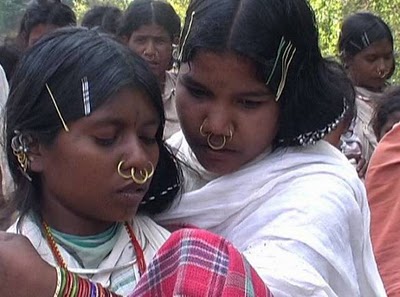'How The Supreme Court Played Havoc
With The Ecologically Sensitive Niyamgiri Hills'
By Devinder Sharma
29 August, 2010
Ground Reality

Dongaria Kondh tribes are not grass-eaters.
Pic by Amnesty International
A day before I had talked about Supreme Court's numerous verdicts (and some suggestions) about rotting foodgrains. The day the Supreme Court suggested that foodgrains should be distributed to the poor than allowed to rot, I was asked by Rajdeep Sardesai on CNN-IBN as to what I thought of it. I had said that I am not much enthused by Supreme Court's suggestion because it has never pulled up the State government's for not complying with its earlier orders on ensuring that no one goes to bed hungry.
Merely making such statements does not make any difference. Unless of course His Lordship hauls up the Chief Secretary of a defaulting State, and sends him/her to judicial custody for not complying with its orders, things will not change.
Having said that I was pleasantly surprised when I read a Times of India article today (Aug 29, 2010) wherein it said: The Lanjigarh refinery shows how the Supreme Court played havoc with the ecologically sensitive Niyamgiri hills, which are home to 8,000 Dongaria Kondh tribals. This to my mind is the first time I am seeing such a clear analysis of Supreme Court's role in a controversial mining deal. Going through the article I must say I felt like raising my hands to offer my salute to the writer, Manoj Mitta.
Lanjigarh alumina refinery was to draw bauxite from Niyamgiri hills in Orissa. "In a bizarre reversal of roles, Environment Minister Jairam Ramesh all but over-ruled Kapadia's decision to grant bauxite mining project the right to clear forests in the Niyamgiri hills, where the 8,000 Dongaria Kondhs live."
Justice S H Kapadia is now the Chief Justice of India.
Manoj Mitta goes on to write: "Clearly, the lapses that have come to light go beyond Vedanta and the Central and State governments. They extend to the Supreme Court as well." Accordingly, the author of the Vedanta verdict -- Justice S H Kapadia -- had made it clear how he saw the Dongaria Kondhs, who are officially classified as 'primitive tribal group'. Kapadia, now chief justice of India, described this tribe from Orissa as a people "living on grass."
Following the widespread criticism of the dilution of charges by the former Chief Justice of India A H Ahmadi against the Union Carbide in the Bhopal gas tragedy case, I feel the nation is now becoming mature enough to evaluate, analyse and scrutinise the meaning and implications of court judgements. This is a welcome sign, and indicates the evolution of a healthy and vibrant democracy.
Kapadia did not call the Dongaria Kondhs grass-eaters in either of his orders he wrote in the Vedanta case, the article goes on to say, but the fact that he did so in a public lecture, which was reproduced full in a law journal, may underline all that was wrong with the basis of his judgement. In the modern idiom, he might have seemed to have shown where he was coming from?
At a time when the government itself is considering making it obligatory for the mining companies to pay an enhanced royalty of 26 per cent, I am surprised to learn that Justice Kapadia had come up with an economic formula -- 5 per cent of the project profits would go to tribal welfare -- ostensibly to balance the conflicting interests of development and environment.
You can read the complete article here: http://timesofindia.indiatimes.com/home/sunday-toi/special-report/Who-will-save-our-Navis/articleshow/6453608.cms
Now before I end, I would like to draw your attention to another interesting analysis in the same newspaper, and also about the same issue. Senior journalist M J Akbar in his column Out of Turn (Aug 29, 2010) looked into Rahul Gandhi's support of the tribals and farmers. He says that it has always been clear to Delhi insiders that Digvijay Singh opened a front against P Chidambaram with Rahul Gandhi's permission. Outsiders now have confirmation.
I found this particular para not only very interesting, but also reflecting the ground realities. The Congress has set out to be the party of the poor in daytime, and of the rich at night. Its sunlight politics will fetch votes, its twilight policies will enable it to govern. This is an extremely clever act whose opening scenes are being played out for a new generation that is vague about Indira Gandhi and amnesiac about Nehru. The hero of this drama must have the christma to dazzle the poor and the flexibility to keep the rich onside. That is the challenge before Rahul Gandhi. His avowed role is to be the guardian of the poor in Delhi, which means that the poor need protection from Delhi. He is at home with the elite in the evening and is now making the effort to capture the sunshine hours.
Oh, dear ! Have we really evolved as a healthy and vibrant democracy?

